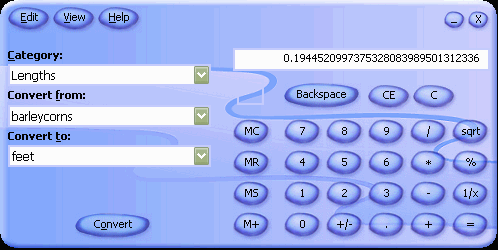To finish the talk I’ll touch on customization and deployment of the CSK, which hopefully doesn’t put everyone to sleep. If it does, I plan to make off with all the free pizza, soda, and raffle prizes before the audience wakes up.
On October 16th and 17th I’ll be at Microsoft’s Waltham, MA facility for Code Camp II: The Return. I have a session to talk about techniques for integrating SQL Server Reporting Services into ASP.NET applications. Although I have not spent much time with the report designer I have spent a fair amount of time investigating ways to hook into SSRS programmatically. This talk will focus on improving the sample report viewer component for use in the real world, and tips / tricks / traps with the web service API.
I only hope my session doesn’t overlap with some of the sessions I really want to see while I’m there, because there is some great looking content and speakers. I also hope this software developer from Boston doesn't show up, because quite frankly, she scares me.
I have a slew of SSRS articles to build from, you’ll probably see more here soon as I work on the presentation.
Authentication, Role-based Security, and SQL Reporting Services Web Services
Introduction To Role-Based Security In SQL Server Reporting Services
Embedded Code In Reporting Services
Using GetReportParameters in Reporting Services
Using CreateSubscription and the Reporting Service API
SQL Reporting Services Tree Navigation Sample using a Web Service API
Microsoft Calculator Plus is now available!
Update: The CalcPlus link seems to lead nowhere now. It really did exist for a time. Donna Buenaventura saw it too. The plot thickens....
Everyone has been talking for years about how Microsoft has killed calculator innovation by including calc.exe with the operating system. After all those messy anti-trust suits and allegations of anti-competitiveness, Microsoft has finally answered the critics. The calculator dev team has been back in feature development mode. A new age of calculation is upon us. Prepare your eyes as I now convert barleycorns1 into feet!!

1: From Sizes.com. In England and Scotland, at least as early as the 12th century an inch was thought of as 3 barleycorns laid end to end. A document of 1474 states: “III barley corns take out of the middes [middle] of the Ere make an Inche and XII inches makith a foote and III fote makith a yarde.”
SELECT * FROM ownername.tablename
SELECT * FROM servername.databasename.ownername.tablename
What would confuse me was why anybody would want an owner name - a login - appearing as part of a fully qualified database object name. This creates all sorts of limitations. If an admin needed to remove a user, all the objects belonging to the user had to be dropped or reassigned – breaking all queries, views, and stored procedures with two part names. Since nobody wanted to tie an object to a user, we created databases where dbo owned all objects – forcing permissions to be granted on an object-by-object basis.
Linking users to objects also created all sorts of unfortunate naming conventions. Take .Text for instance, which prefixes all database object names with “blog_”. Likwise, the Community Starter Kit prefixes all object names with “Community_”. This practice allows these applications to work in hosted environments and share a common database without object naming collisions, but it feels ugly.
Thankfully, SQL Server 2005 gives us schema. Objects now belong to a schema. A database may have multiple schemas.
SELECT * FROM schemaname.tablename
SELECT * FROM servername.databasename.schemaname.tablename
No longer does the designer have to worry about naming conventions to group tables. A database designer can instead think about what the functional area of a table will be. For instance, the new AdventureWorks sample database in 2005 groups user tables into schemas like “HumanResources” and “Shipping”.
Schema separates users from database objects and functions similar to a namespace. The schema is also a container, and permissions can be assigned at the schema level instead of on individual objects. Schemas are an additional layer of indirection. Admins can drop users without worrying about reassigning object ownership. Schemas are flexible. Queries with two part names don’t feel so brittle anymore.
I thought of a little saying. It goes like this:
Users come and go, but schemas are forever.
Is this poetic? Or Corny? Does it belong in a book of prose? Or printed on some t-shirt and sold at a discount stand by the beach?
John is addicted to chocolate. I think I am too. Just recently, I noticed a new product in the vending machine at work. It’s a chocolate bar with miniature M&M’s inside. Just think – you have pieces of chocolate inside of hard candy shells then embedded into a larger bar of chocolate. Human achievements just never cease to amaze me.
I somehow resisted the urge to plunk money into the machine and go on a chocolate feeding frenzy. I wish they wouldn’t keep these in the machine - it would be much easier to resist the spicy pork rinds Heather finds in the vending machines at Microsoft. I’m 40 pounds lighter than I was in 2002 and I’m not going back. I carefully monitor my chocolate intake.
In my searches for the latest in chocolate tech, I discovered the “Course In Chocolate Technology”. This course covers everything from cleaning, roasting, winnowing, and grinding the cocoa bean to chocolate viscosity exercises with polyglycerolpolyricinoleate. Doesn’t that sound yummy? Maybe understanding the underlying science and chemicals of modern chocolate manufacturing would cure my addiction.

 OdeToCode by K. Scott Allen
OdeToCode by K. Scott Allen